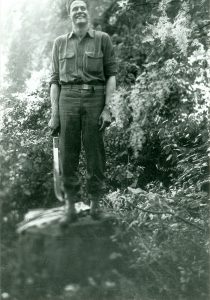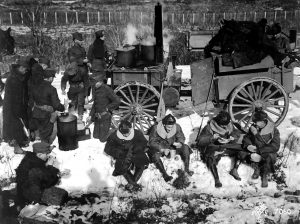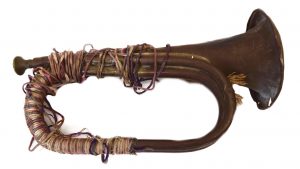By Christopher Marty
The War of 1812 had a significant impact on the United States and reinforced the need protect the nation’s seacoast from enemy attack. The young nation’s Army fought ably at Baltimore and New Orleans, was routed at Detroit, suffered the capture and destruction of Washington, and garnered mixed results around Niagara. The embarrassing loss of Washington, the nation’s capital, highlighted preventative weaknesses that remained until the Civil War. Though the country fought magnificently at Fort McHenry in Maryland and Fort St. Philip in Louisiana, as well as on the battlefield at places like Chippewa and New Orleans, the United States’ primary weakness resided along the seaboard. The young republic simply could not deny the British the ability to strike anywhere along its coastline.

After the war, the U.S. Army found itself with two primary missions: maintaining stability on the frontier, which entailed significant conflicts to differing degrees with indigenous peoples for the next seventy-five-plus years, and protecting the seacoast against possible European incursion. Throughout the nineteenth century, the Royal Navy possessed unmatched, near-worldwide freedom of maneuver on the sea. Additionally, the French and Spanish retained capable fleets with Caribbean ports. Therefore, by 1816, the Army needed to block east and south against potential future European aggression while conducting a nineteenth-century version of stability operations westward, interspersed with occasional conventional battles across the continent.

The nation learned to conduct successful physical defenses of critical port cities like Baltimore and New Orleans. Notably, New York City and Boston also possessed significant fortifications and, by the conflict’s end, neither was threatened by the British. The best option for the Army was a doctrine of deterrence by limiting the enemy’s choices to shoreline denial or to accept a fight with tremendous casualties. In peacetime, prosperous nations improved their defenses to prepare for the future. After the conflict, the United States used this period of relative peace to successfully deter future attacks.

As a response, the Army Corps of Engineers created the Third System of Coastal Defense (1821-1866) from Maine to Louisiana, with additional posts in California. After the War of 1812, these new fortifications, designed to safeguard economic centers, ports, and U.S. naval bases, all while assuaging the public against foreign aggression, soon dotted the map. Over the next fifty years, regulars and state militias garrisoned these posts with the tacit understanding that Britain might attack with a far more powerful Royal Navy than in the past. In 1859, U.S. Army engineer John G. Barnard called the country’s ability to defend New York City against the British the “Great National Question.” In his book, The Dangers and Defences of New York, Barnard did not see an invasion as an “if;” instead, he saw the potential act as a “when.” Eventually, when the British Army landed again on American soil, augmented by the Royal Navy, would the Army stand ready?
Understandably, the American people did not want their land seized or buildings set aflame by marauding enemy soldiers, nor did they want their coastlines blockaded, which might strangle a growing economy. To remedy this, Army engineers, many educated at the U.S. Military Academy, sought to use their skills to build military and civilian projects to bring science and math into warfare through crafting fortifications at set locations, which proportionately eliminated risk, luck, and chance on future battlefields. They evaluated terrain for site selection as early as 1817 and included anticipated timing for militia reinforcement. Engineers tested the resistance of different types of stone and masonry to projectiles, and they consistently advocated their positions through the Army and within Congress.
Simon Bernard and Joseph G. Totten led the Corps of Engineers through planning and building the Third System. Bernard’s experience fighting under Napoleon and dislike for the British made him an ideal leader for the creation of a new American defensive program. Often, the sites featured variations of stars or pentagons, “owing to the labor and construction” in terms of protection and cost. Many of Bernard’s earlier designs, like Fort Jackson, Louisiana, and Fort Morgan, Alabama, featured five grand bastions each.
Totten would lead coastal defense development for decades and served as the Army’s Chief Engineer from 1838 to 1864. As the American standard bearer and voice of mid-nineteenth-century seaboard fortifications, he individually managed the building of multiple northern forts. His plans, arguments, and construction remained relevant into the next century.
The Third System, created as the first U.S. national defense program, eventually included forty-two significant fortifications on key terrain, with several modernized additions within varying degrees to older sites. The plan’s design combined elements of the Regular Army, militias, and the U.S. Navy to safeguard the nation against future aggression. While the locations possessed radically different shapes and sizes from post to post, which offered tactical variations on area denial concepts, many sites retained similar defensive concepts.

After arguments on cost in 1821, the Fortifications Board recommended a building program in phases. Developments first safeguarded potential enemy amphibious landing sites, significant cities, and later naval bases. The board primarily worked with Presidents James Madison and James Monroe, and John C. Calhoun, who served as Secretary of War, Secretary of State, U.S. Senator, and Vice President during his long and distinguished career, and who consistently supported coastal protection over several decades. Building projects, like massive brick and masonry forts, presented political issues over which U.S. regions first received allocation and construction. Even as late as the 1820s, the populace did not want a considerable-sized national standing army. Permanent forts provided an alternative and exponential combat power that did not require thousands of soldiers to house, feed, and train.

A significant portion of the forty-two forts’ site selections dominated their localized regions at further radiuses away from cities than their older Revolutionary, First, and Second System predecessors. For example, during the War of 1812, Castle Clinton was located at the southern tip of Manhattan and protected New York City. Forts Wood and Jay, along with Castle Williams, all visible from Castle Clinton, helped create a layered, interconnected defense, albeit physically close to the urban area of Manhattan. By the 1850s, New York City’s Third System fortifications protected the population center from distant locations along Long Island Sound and The Narrows separating Staten Island and Brooklyn.
Distance from cities allowed the forts to provide a timed defense. If an enemy naval force offloaded soldiers or marines on a barrier island or tried to engage or pass by the fort, dispatched runners would notify the cities to muster the militia and start marching toward the fortification to bolster the garrison. En route, they could also block avenues of approach toward the city. The concepts appeared sound, at least in 1821; however, they became more critical over subsequent decades as U.S. cities grew massively in population and economic value. Proportionately, American cities became terrific prizes for potential hostile enemies over the decades leading up to the Civil War. Seizing or raiding municipalities involved greater risk but suggested a greater reward.
Technological improvements increased the program’s ability to work well over time. Most posts incorporated casemates into their design, which protected and surrounded soldiers while allowing structural integrity and arches to support the weight of multiple tiers of floors. Eventually, telegraphs helped communications and militia response times. Conversely, Third System debates discussed rifled artillery fired from land-based batteries and ships at sea. Arguments erupted in Congress and within the Army over the cost of an initial build of a fixed location, versus the value of a trained militia that retained the ability to maneuver. Once fortification construction ended for each site, the cost dropped to mainly the price of ordnance.
Building forts from supplies across the nation, including local materials, proved the existence of a growing economy. The types of material (stone or masonry) used for construction, proximity to rail and ports for shipping, and skilled employment all encompassed unique challenges in terms of procurement and work. Many southern states used labor from enslaved people for construction, which came with moral considerations. Fort Jefferson, Florida, located in the Dry Tortugas sixty miles west of the Florida Keys and the most remote of the program’s sites, required shipping for all building materials and soldiers from further distances. The post’s position, essentially in the middle of the Gulf of Mexico, obligated specialized planning, management, and navigational considerations. During and after the Civil War, several forts, including Fort Jefferson, became prisons. Probably the most famous person held there was Dr. Samuel Mudd, who was imprisoned for his involvement with John Wilkes Booth, however questionable, following the assassination of President Abraham Lincoln.

Though few soldiers garrisoned the forts during peacetime, each location’s complement expanded rapidly during a conflict. Most fortifications increased from just a few men, or even a single soldier/caretaker, maintaining the fort and ancillary equipment, such as lighthouses, to hundreds or thousands in each region during the Civil War. Some designs for minor locations outside of New Orleans accounted for zero soldiers in peacetime.
Depending on the post, soldier life came with considerable loneliness, like at Fort Jefferson. Conversely, garrisoned soldiers proximate to towns felt they were “spared the physical isolation” that their counterparts underwent. Several locations, like Fort Taylor, Florida, and Fort Trumbull, Connecticut, justified access since the defenses resided on the city’s edge. Other posts, however, geographically remained in the middle, far enough from cities but not too distant, such as Fort Morgan and Fort Gaines in Alabama, which defended the port city of Mobile.

Doctrinally, the mid-nineteenth-century Army did not use “levels of warfare” terminology. Generally, the strategic level encompassed the two defensive ideals along the coastline and western frontier. Period seaboard operational-level regions contained sizable population areas with multiple, layered Third System forts defending seaborne avenues of approach. New Orleans, Boston, New York City, San Francisco, and Pensacola retained prime examples of elevated protection.
In 1859, two years before the Civil War’s outbreak, Barnard argued possible outcomes for a future war with any first-rate naval force. Based on a fortification’s robustness, navies tended to quickly pass by fortifications or reject confrontation instead of challenging stalwart, well-armed defenders surrounded by stone. Barnard’s “Great National Question” incorporated where Britain might strike “great blows” against “our own great maritime places” (Barnard’s emphasis), which likely meant moving against operational-level regions. Moreover, while he remained vociferous, he did not fancy himself an alarmist since he assessed then-current U.S. power as able to deny Britain permanent footholds. Barnard accurately evaluated the threat and acknowledged that time remained favorable for invaders combining escalated economic and military power. The Royal Navy and English industry in the 1850s and 1860s employed superior, exponential capabilities over their previous generations.

The Crimean War (1850-53) demonstrated how Britain and France transported nearly 400,000 soldiers on fleets built and powered through modern industrialization, shipyards, and steam, combined with the seizure of key coastal terrain against the Russians. Six years later, Barnard believed European nations possessed the capacity and necessary type of experience for invasion but lacked a “motive” to move against the United States. Britain might gain traction in providing a spark for war using potential unrest in Maine, which could cede the state to Canada, though Barnard did not acknowledge that possibility. Mid-nineteenth-century operational-level regions like New York City and Boston became possible war trophies to far greater degrees than in previous wars due to European nations’ potential. The program’s defenses needed sufficient strength to deny or deter planned seizure, which, in turn, would answer Barnard’s “National Question.”

New Orleans, the weakest operational-level region at the end of the previous conflict, required permanent protection after the successful battlefield defense in January 1815. The Fortifications Board intended to patch Louisiana first since the city’s location on the Mississippi enabled significant trade and travel throughout the continent’s center. The Royal Navy’s maneuverability and the state’s numerous waterway passages added to planning difficulties. When complete, the defenses included Fort Pike and Fort Macomb located east at the Rigolets, Fort Jackson along the Mississippi River, and Fort Livingston directly south in the Barataria Channel, with several other minor defenses dotting the region.

Boston possessed two primary Third System sites at Fort Warren and Fort Independence and a smaller location with Castle Winthrop. Fort Warren’s sheer enormity as “the Key to Boston Harbor” dwarfed most of the program’s other defenses. The fortification boasted three total levels and 15-inch Rodman cannons, whose range fans covered every direct seaborne approach to the city. If any enemy passed or defeated Fort Warren en route to the population center, then they still needed to engage Fort Independence and Castle Winthrop on the shores of Boston’s Main Channel.
New York City’s two main seaborne avenues of approach from Long Island Sound and the Narrows (now more commonly known as the Verrazano Narrows) possessed two and four Third System defenses, respectively. Toward the northeast, Fort Schuyler and Fort Totten squeezed the cramped Hells Gate passage, blocking naval paths toward the East River. Southward, Forts Tompkins, Lafayette, and Hamilton presided over the slightly wider Narrows. Additionally, Fort Richmond, one of only two four-tier defenses in the country, dominated the water’s edge on Staten Island. New York City’s combined defenses furnished more protection with sizable forts, cannons, and soldiers than any other operational-level region. Of these, only Fort Hamilton remains an active Army post, and it hosts a number of Army activities, including the New York City Military Entrance Processing Station (MEPS).
California’s isolation from the rest of the United States required safeguarding, so the board included Fort Point and Fort Alcatraz. Arguably, San Francisco needed to be able to support and defend itself alone due to the rest of the country’s inability to provide quick assistance across the continent. Despite being geographically small, Fort Point commanded the Golden Gate as the nation’s other four-tier fortification. Long before notoriety as a twentieth-century prison, Fort Alcatraz defended the inner bay on a craggy island and, of all the program’s creations, did not look like the others. Alcatraz’s rocky, elevated surface did not require smooth, angled, manufactured scarps to a similar degree as eastern forts.
Four Third System sites safeguarded the Pensacola naval base. The region’s unique geography allowed for potential amphibious attacks along the entirety of the barrier islands, bay, and even an overland route, which the program protected with an advanced redoubt. Fort Pickens, the largest of the four by a considerable margin, dominated the main channel into the bay from Santa Rosa Island. Perdido Key’s Fort McRee, the only Third System site on today’s seaboard initially defended the west passage. Fort Barrancas centrally protected the others as a second layer, with an older, Spanish-built water battery at the shoreline.
Tactical-level areas could possess a single Third System fortification. The Delaware River provided waterborne access to Philadelphia, Wilmington, the railroad, and the northern overland route to Baltimore. Fort Delaware, a mighty fortification on Pea Patch Island, took a considerable time to acquire and construct. The location occupied the southernmost defensible site on the river and could be armed with 150 guns.
Fort Adams, Rhode Island, widely considered the pinnacle of period fortification design, could expand to 2,440 defenders during the Civil War. Located in Narragansett Bay and constructed under Totten’s direct supervision, the site’s tactical usefulness secured unique advantages. Adams protected the bay and the best anchorage between Boston and New York City. British invasion possibilities included seizing Newport, neutralizing the U.S. naval base, then starting from a central position to march to either city.
Often, minor rivers and inlets necessitated security. Fort Clinch safeguarded the St. Mary’s River on the northeast border between Georgia and Florida. Fort Clinch’s earthen wall provided extra strength, and the site did not observe heavy combat during the Civil War. Furthermore, the post defended a primary entrance into the intercoastal waterway, like Forts Caswell and Fort Macon in North Carolina.

As construction of the Third System drew near completion, more soldiers defended naval avenues of approach behind mammoth walls of granite or masonry. Over the decades, improvements in cannons, mortars, and steam technology eased the ability of hostile armies and navies to impose their will on U.S. soldiers. During the Civil War, coastal forts fell under attack from the land, whether by Union or Confederate. Far from the program’s original intent, the design incorporated local militia, which reversed in 1861, then worked against the Union. Confederates garrisoned the defenses, then operated against their external amphibious enemies. Unfortunately, the Civil War changed the dynamic of the fortification program and the soldiers who defended the coastline.
With a few exceptions, Confederates seized most Third System fortifications along the Southern coastline. Forts Monroe and Fort Wool near Norfolk, Virginia, however, remained in Union hands throughout the war. The two defenses securing Hampton Roads witnessed several critical events, including Major General George B. McClellan’s landing and movement inland toward Richmond with his Army of the Potomac, the first aerial reconnaissance in world military history, and the historic battle between the USS Monitor and the CSS Virginia (built on the former USS Merrimack).
In Florida, Fort Taylor, Fort Jefferson, and Fort Pickens also did not change hands. Up north, posts defended against piracy and often served as prisons. The Union’s forts retained similar invasion possibilities from earlier European adversaries, such as restricting shipping from a distance or bypassing. In the South, seizing fortifications meant fully closing safe harbors upriver for blockade runners. Eventually, Union bombardment from rifled land-based batteries penetrated the walls of Fort Pulaski, Georgia, which closed off the port of Savannah for potential for trade.
In 1861, the British received intelligence reports about the state of the Union blockade on the Southern coastline. British leaders consistently spoke with one another on the war’s status and maneuvered their ships off the seaboard with knowledge gleaned from those documents. They possessed naval and army posts of various degrees in Canada, in the Atlantic and Caribbean, and at Esquimalt near Victoria, British Columbia, which strategically surrounded the country, delineating threats right outside the nation’s door.
Halifax and Bermuda could garrison up to 20,000 soldiers each during any conflict, numbers not easily dismissed for the early Civil War if the British joined on the side of the Confederacy. The Royal Navy raised their shipping strength in the Atlantic to numbers unseen since the War of 1812, and Bermuda’s position with a three-day steam to the coastline presented opportunities. The British possessed an operational reach and potential for blockades and amphibious landings, up to the seizure of U.S. critical and symbolic centers of power. Any offensive British course of action could seriously disrupt the Union’s ability to wage war against the Confederacy.
John Washington produced a report in December 1861 that provided a detailed intelligence-related analysis of U.S. Third System forts and the Royal Navy’s ability to traverse all important seaborne avenues of approach. Vice Admiral Alexander Milne commanded the Royal Navy’s North America and West India Station during the Civil War. The document highlighted the depth and width of most U.S. bays, rivers, and waterways, which could affect British choices to bypass or challenge fortifications, landing sites, and the ability to resupply. The British successfully evaluated U.S. terrain, weather, civil considerations, and in most cases, the power of each Third System fort on an individual basis along the Union Atlantic and Gulf coastlines.
The British document noted Barnard’s published, argumentative statements within Dangers and Defences of New York, which demonstrated their open-source information collection capabilities for the time against the United States. In the report, Boston and New York remained the two most significant locations for the British to seize or neutralize. The former’s “strength of the forts” and hazardous waters meant that, according to the British, “Boston could not be attacked with any hope of success.” The report acknowledged Fort Adams’s additional, considerable toughness when adding the lengthy, southern approach from Rhode Island. Deterrence worked for Boston.
The report provided multiple descriptions of New York’s fortifications. Fort Schuyler’s power denied the northeastern approach from Long Island Sound. The British granted an accurate description of the four posts along The Narrows, with the report stating that an attack on New York “is by no means recommended;” however, it offered a plan bypassing the sites as quickly as possible, yielding limited strategic results. New York City, like Boston, maintained sufficient defenses to deny Britain possible military methods of invasion and intervention strategically.
Beyond intelligence, the report concluded with an operational perspective listing the total number and types of ships the Royal Navy might require conducting a blockade per seaborne avenue of approach against a list of U.S. cities. The document did not assess Union shipbuilding, including ironclads, which might penetrate any British embargo; however, the publication date predated the battle of the USS Monitor and CSS Virginia by four months.
Washington’s report within Milne’s papers is one of the most crucial historical documents in fully understanding the effect of Army coastal defense operations in the mid-nineteenth century. Army engineers and politicians did not design and approve the Third System in the 1820s, assuming that a prospective Confederacy forty years later might seize Forts Sumter, Fort Morgan, and many others, nor that they may have to re-seize those locations in a bloody war. Union artillery battered Fort Pulaski into submission in 1862, which challenged the physical effectiveness of masonry, but the fortification’s design never intended for the United States to attack itself.

Bernard, Totten, and Barnard remained correct in pre-war assumptions that the combined British Army and Royal Navy existed as the U.S. Army’s primary foe during the mid-nineteenth century. If they needed to intervene in the Civil War, Royal Navy leaders led, in writing, with a possible blockade instead of challenging forts and the British Army conducting close combat with U.S. soldiers. Their choice stressed the British inability to militarily succeed to nearly any degree against the Union in 1861. The British never chose to engage U.S. soldiers again after the War of 1812, and Milne’s report fifty-nine years later finally closed the book on invasion.
Milne’s report accurately depicted the Third System’s power and answered Barnard’s “National Question.” Quietly and with no conflict, the Corps of Engineers’ planning and advocating of building and incorporating soldiers into a coherent structure over decades rendered any fears of invasion irrelevant. The first nationally funded defense program succeeded with the efforts of thousands of U.S. soldiers who occupied the fortifications for decades against an enemy who never came. During the Civil War, the Union did not just overcome the Confederacy. The United States won a second, silent strategic victory against Britain through deterrence, even as the nation battered and wounded itself across the continent.
Since 1865, several Third System forts found a second life with technical, modernized modifications to support coastal defense into the early twentieth century, though many retained their initial design. Others remain as private property, state parks, or federalized within the National Park System. Today, the forts that protected the coastline against hostile European armies and navies stand as a reminder of deterrence and perseverance.



